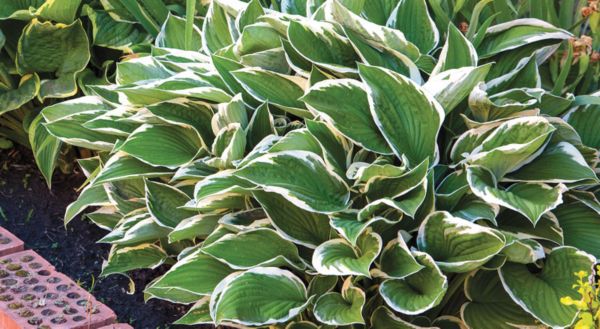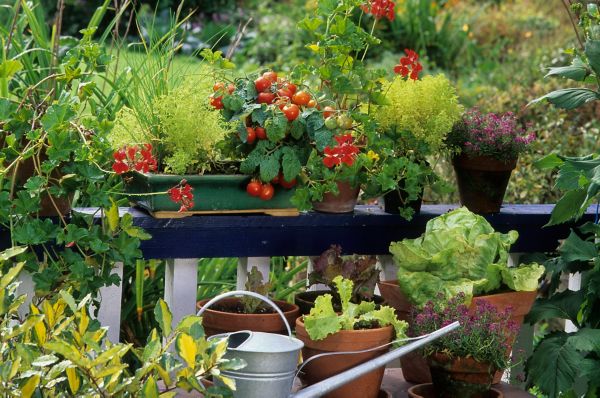How to Grow Tomatoes
Authored by Leah Chester-Davis
This favored vegetable of summer can be grown in containers on a sunny patio, in raised beds or in a garden plot.
Tomatoes are one of the most popular plants for the home garden, and for good reason! They are a versatile vegetable that can be eaten raw in salads or on sandwiches. They can be roasted, stewed, or stir-fried for a variety of soups, stews, sauces, and other dishes. They can be preserved by canning them whole, diced, or as a sauce, which can also be frozen.
Tomatoes are also valued for the nutritional attributes such as lycopene which helps protect against cancer and cardiovascular diseases. They are rich in antioxidants, vitamins A and C, and numerous nutrients that contribute to overall health.
About tomato
| Botanical name: | Solanum lycopersicum |
| Common name: | Tomato |
| Plant type: | Tender, warm-season vegetable; Cherry, Grape, Roma or Plum, Beefsteak, Heirloom |
| Size: | Dwarf (2 to 5 feet), Determinate (1 to 5 feet tall), Indeterminate types (5 to 8 feet tall) |
| Sun exposure: | Full sun, at least 6 to 8 hours each day |
| Soil type: | Moist, well-drained |
| Soil pH: | Slightly acidic, 6 to 6.8 |
| Hardiness zones: | Numerous zones; your zone may dictate variety |
| Average first frost: | Varies by region |
| Average last frost: | Varies by region |
| Container friendly: | Yes; Dwarf and Determinate |
| Beginner friendly: | Yes |
Growing
Tomatoes are warm-season plants. Get a head-start on the growing season by getting seeds started indoors. Another option is to buy seedlings at your local garden center around the last frost-free date in your area. Wait until about two weeks after the last frost-free date to plant them outside. They typically thrive when temperatures are 70 to 80 degrees during the day and when nighttime temperatures don’t dip below 60 degrees.
Tomatoes are sun lovers. Select a site that gets at least 6 to 8 hours of direct sunlight each day.
Tomatoes prefer a well-drained, fertile, moist soil with a pH of 6.0 to 6.8. If possible, take a soil sample in the fall and follow recommendations before spring planting.
Terms you will often see when looking at seed catalogs or selecting plants from a garden center are dwarf, determinate and indeterminate, which give a clue as to the size and growth habit of the plant.
If tomato selection is limited at nearby garden centers, it’s often possible to find seeds of different varieties. It can also be a cost-saving measure. A packet of seeds is often less than purchasing tomato transplants that are ready to go into the garden.
Determinate varieties have a more compact growth habit than indeterminate varieties. They are sometimes called bush tomatoes for their shorter, stockier habit. They grow to about 4 feet. They flower and set their fruit within a short period of time, usually over a 4- to 5-week period. They usually produce earlier than indeterminate varieties. Because they produce a large amount of fruit over a short period of time, they make it convenient for those who like to can or freeze them.
Indeterminate varieties grow quite large, to about 6 feet. They will flower and set fruit for a longer period, usually until frost.
Dwarf varieties are typically 2 to 4 ½ feet, making them desirable for small spaces such as patios or balconies. These are good choices for growing in containers. While the plant itself may be smaller, the size of the fruit may be large and flavorful. Dwarf varieties can be either determinate or indeterminate.
If you prefer to purchase tomato plants, instead of starting them from seed, select sturdy, dark green plants. Avoid those that are tall or leggy and have yellowish leaves.
Planting
After the danger of frost has passed, the soil has warmed, and the plants are hardened off, it’s time to put them into the ground. Days to maturity after transplanting is typically 65 to 90.
Plant tomato plants deep, about 3 to 6 inches into ground or where the soil level is just below the lowest leaves. If planting in containers, use a good quality potting mix.
If planting several, give them plenty of room to grow. Space them about 2- to 3-feet apart.
Stake plants during or soon after transplanting so you don’t damage roots. Look for sturdy stake options such as wooden tomato stakes. As the plants begin to grow, pull them gently toward the stakes and tie loosely with twine or cloth. Cattle fencing panels that can be cut and bent to form supportive cages are another option. They provide support for the plant and are particularly useful for indeterminate varieties. Cages available at your local garden center may work for dwarf varieties.
Fertilizing
- Use a starter fertilizer at the time you put transplants in the ground. Fertilizer is available in both organic and inorganic forms. Follow label directions.
- Sidedress or sprinkle fertilizer around the plant a couple of times during the growing season. Apply about 3 tablespoons of 10-10-10 fertilizer around each plant (but not touching the stem) when it begins to fruit. Add the fertilizer when the fruit is small, about 1 inch in diameter. Work it into the soil. Make another application every 4 to 6 weeks throughout the growing season.
- If using organic fertilizer, follow label directions.
Controlling Pests, Diseases, and Other Problems
- Tomatoes like evenly moist soil. Keeping the soil evenly moist will help reduce or prevent blossom-end rot. Do not allow the soil to become too dry.
- Tomatoes are susceptible to blight. If you grew tomatoes in your garden the previous year, grow them in a different location this year. Wet leaves, particularly overnight, can cause problems. Water during the day and avoid wetting the foliage.
- Good air flow is important; that’s why spacing your plants at least 2- to 3-feet apart is important.
- Destroy any affected plants; don’t add them to your compost pile.
- Tomatoes are susceptible to fusarium and verticillium wilt. The above cultural practices will help. Look for varieties that have resistance to these diseases.
- Essential natural oils and other organic forms of pest control are available in garden centers, in addition to insecticides.
Harvesting and Storing
When the fruit begins to change color, it has begun the ripening process. One of the best ways to avoid cracking and splitting problems is to pick the fruit when it starts changing color, rather than waiting until it is fully ripe. Set the tomatoes on your countertop and they will continue to ripen at room temperature. Do not refrigerate.
At the end of the season and before the first frost, pick any green tomatoes on the plant and allow them to ripen indoors.
Storing
Tomatoes do best when stored in a single layer in a cool room. If you have picked them just before ripeness, they will continue to ripen if left at room temperature or in a cool space. Do not refrigerate.
Fully ripened tomatoes can be refrigerated; for best flavor, bring to room temperature before slicing and serving.
To store green tomatoes, wrap each in newspaper and store in one layer in a cardboard box. Store in a cool, dry place. If you have large quantities, too many to individually wrap, store on layers of newspaper and top with newspaper. Check every couple of weeks for ripened tomatoes.
Tomatoes can be frozen, canned, or dried to preserve the delicious flavor for year-round use.
Expert Tips
- Get in the habit of feeding your soil with good quality compost; this will reduce fertilizer needs.
- Rotate your crops; avoid planting tomatoes in the same spot for three years.
- Keep soil evenly moist; don’t let it dry out.
- Keep foliage dry when watering to reduce introduction of diseases.
- Give plants plenty of room to grow and to allow for good air flow.
Frequently asked questions
What causes large, black spots on the bottom of my tomatoes?
Blossom-end rot is caused by a lack of calcium in the fruit. It’s often due to uneven moisture levels, which can inhibit calcium uptake. The best way to avoid it is to keep soil evenly moist and don’t let it dry out or get waterlogged. Make sure your soil pH is in the 6.0 to 6.8 range.
Why do my tomato plants look wilted even though I keep them watered?
The likely culprit is fusarium wilt that is caused by a soilborne fungus. Many tomato varieties are resistant to this disease. When selecting seeds or plants, check the name. It will contain the letter F after it, which indicates its resistance to the disease. Either remove the plant or apply fungicide by following label directions.
What can I do if the foliage on my tomatoes has circular spots that turns yellow and drops off?
This sounds like it may be Septoria leaf spot, which starts at the bottom of the plant and spreads. When you first notice this problem, remove infected leaves, and dispose of out of the garden. If problem persists, start a fungicide spray treatment; follow the label directions.





